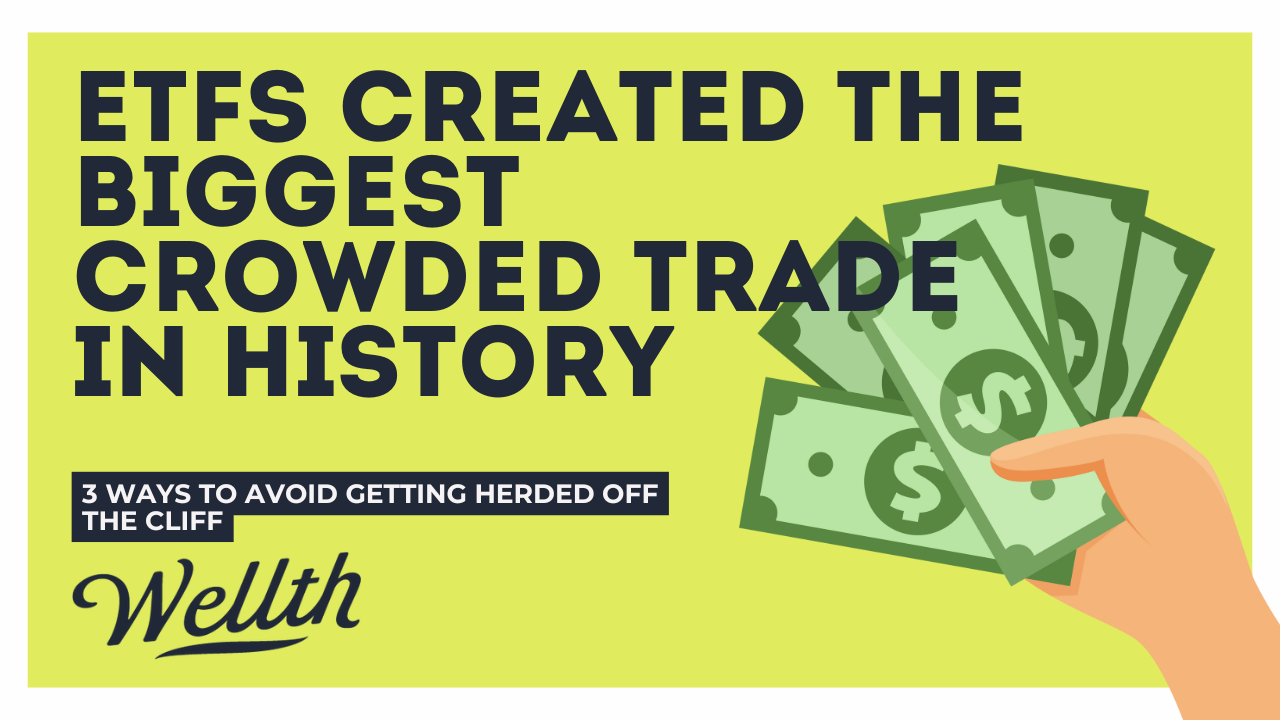ETFs Created the Biggest Crowded Trade in History
3 Ways to Avoid Getting Herded Off the Cliff
Index ETFs were sold as the safest way to invest.
But here’s the problem: they don’t just mirror the market — they shape it. Trillions of dollars flowing into the same indexes are funneling capital into the same handful of companies, amplifying their weight in ways most investors don’t see. What feels like diversification is often just momentum in disguise.
And when everyone crowds into the same trade, the exit door gets very small.
Let’s understand why this is and the 3 steps you can take to protect your portfolio.
How It Works: Market-Cap Weighting = Momentum Chasing
Most index ETFs are market-cap weighted. That means the bigger a company’s valuation, the more of your money flows into it.
When Apple, Microsoft, or Nvidia climb in price, their weight in the index increases. As new ETF money arrives, more gets allocated to those same stocks, driving them even higher.
It’s a feedback loop: higher prices attract more flows, and more flows push prices higher. It works brilliantly on the way up.
But when momentum breaks, the cycle reverses — pulling everything down in unison.
Here’s the catch: this wasn’t always a glaring problem. When indexes were more balanced across sectors, market-cap weighting provided a reasonable snapshot of the economy. But today, with a handful of mega-cap tech names dominating index weightings, the structure amplifies concentration risk in a way it never did before. The mechanics of ETFs haven’t changed, what’s changed is the level of imbalance they now reinforce.
The Risk: Over-concentration and Fragile Diversification
The danger isn’t hidden it’s right there in the index weights.
The S&P 500 has over 500 names, but the top 10 account for nearly one-third of its value. Investors think they own “the market,” but their returns hinge on the fate of a few tech giants.
That’s not diversification. That’s dependency.
And the systemic risk goes further:
Overconcentration: A small set of mega-cap stocks dictate returns.
Feedback Loops: Inflows inflate the winners; outflows punish everything.
Liquidity Crunches: Selling pressure in ETFs translates into forced selling across entire indexes.
Fragile Safety: What looks like balance is actually exposure to the same crowded trade.
This is the paradox of indexing: the very structure that feels safe may be magnifying risk across the system.
What Investors Can Do Instead
The answer isn’t abandoning ETFs. It’s being more intentional about which ones you use and how you build true diversification.
1. Equal-Weight ETFs
Instead of pouring capital into the biggest names, equal-weight funds spread allocation evenly across all index members. This brings mid and small-cap companies back into the portfolio mix, reducing reliance on a few trillion-dollar giants. The trade-off: slightly higher costs and turnover but a more balanced portfolio.
2. Factor Investing (Small-Cap, Value, Quality, Private Equity)
Factor ETFs tilt portfolios toward proven drivers of long-term returns. Small-caps and value stocks, in particular, often outperform after periods of mega-cap dominance. By adding factor tilts, investors diversify away from pure momentum and toward resilience.
3. Think Globally
U.S. indexes are increasingly top-heavy with tech names. Adding exposure to international developed markets and emerging markets broadens the opportunity set and reduces reliance on U.S. mega-caps. True diversification means not putting all your chips on one market cycle.
The Real Lesson: Diversification Requires Intentional Design
ETFs aren’t bad. But they aren’t neutral either. Market-cap weighting hardwires momentum into your portfolio whether you realize it or not.
True diversification requires design: choosing structures that spread risk more evenly, rebalancing before concentration builds, and looking beyond a handful of names or one market.
Exposure isn’t the same as protection. Owning “the index” doesn’t mean you’re safe.
Takeaway: Don’t Confuse Exposure with Safety
Index ETFs have created the biggest crowded trade in history. The irony is that what was sold as safety may prove to be fragility.
The investors who recognize this and take steps now to build intentional diversification will be the ones positioned to withstand the next market storm.
Because when everyone’s in the same trade, the only smart move is to step aside before the herd runs off a cliff.
Disclaimer: This analysis is for informational purposes only and does not constitute financial advice. Investors should conduct their own due diligence and consult with a financial advisor before making investment decisions.


